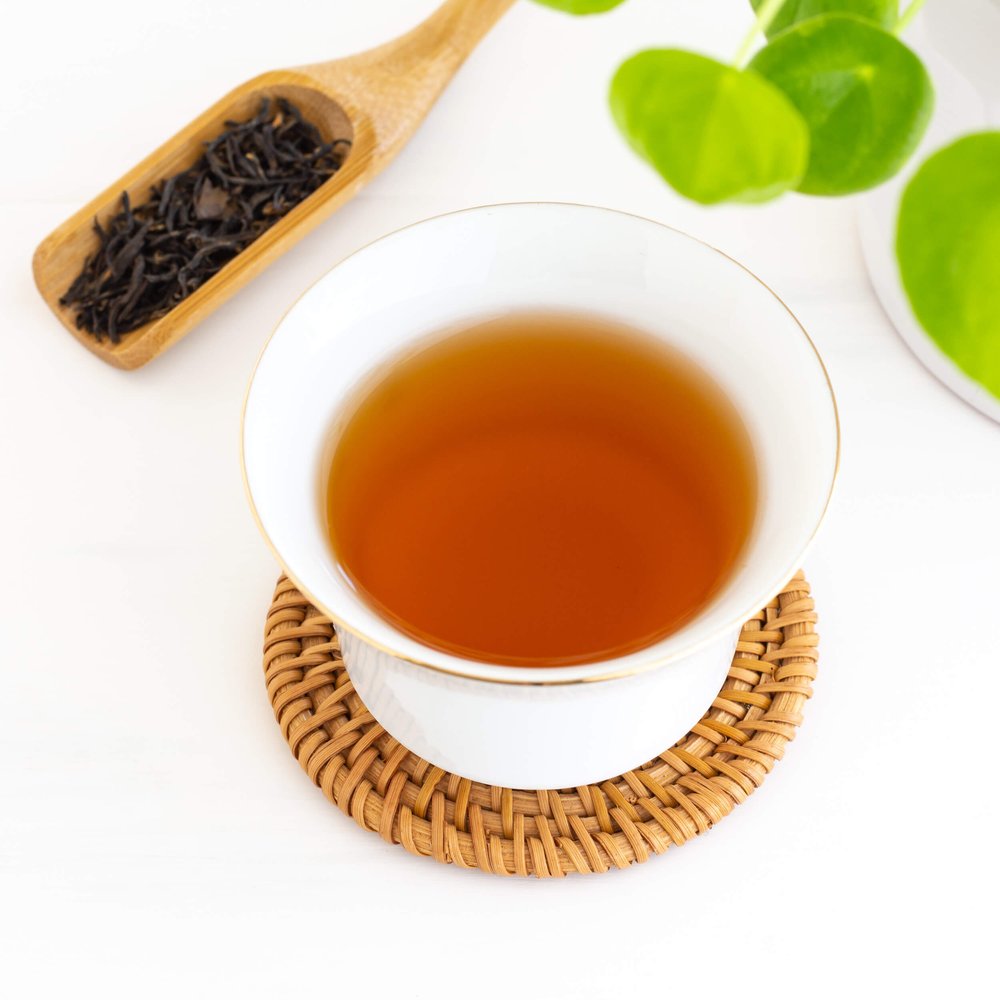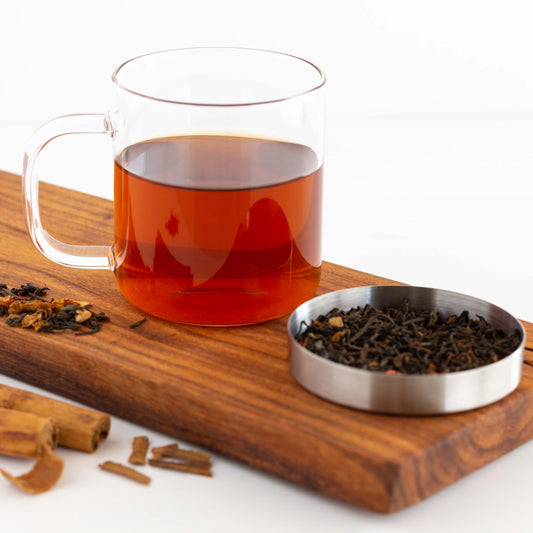Pu-erh tea is an aged, partially fermented tea from the Yunnan region of China. The fermentation process gives this tea a distinctive rich, smooth, and earthy flavor. The cultivation history of this traditional Chinese tea stretches back hundreds of years, and today pu-erh is enjoyed by tea aficionados and newcomers alike.

Pu-erh tea tasting notes
The flavor profile of pu-erh tea is complex and nuanced. While pu-erh can definitely be a bit of an acquired taste, pu-erh fans love the rich, earthy flavor of this unique aged tea.
Rich
Pu-erh brews up a deep black color with a full body and a rich flavor. Because of pu-erh’s richness and depth of flavor, it’s often a favorite for coffee drinkers looking to switch to tea. Some pu-erh teas even look a little bit like coffee when brewed, with a dark black color and a full body.
Smooth
Pu-erh is much smoother than other types of tea. Thanks to the aging process it undergoes, it has none of the tannic bite or acidity of a black tea. Instead, pu-erh is smooth and mellow.
Earthy
Good pu-erh teas have a pronounced earthy flavor that is strong without being overpowering. This flavor is a result of the aging process, and is part of what makes pu-erh so unique and distinct from other teas. While the “earthiness” of pu-erh can be a little intimidating for beginner tea drinkers, it’s a flavor that’s prized by pu-erh fans.
Smoky
Some pu-erh teas have a subtle smoky flavor. While not as pronounce as the flavor of a true smoked tea like Lapsang Souchong, pu-erh teas often have toasty, smoky notes reminiscent of woodsmoke. This smoky characteristic can also lend a dryness to these teas.
Mushroom-y
Pu-erh teas are often described as having a subtle mushroom-like taste. This makes sense, since pu-erh teas are actually partially fermented, with unique microbes and microflora present in the tea.
About pu-erh tea
Pu-erh is a type of heicha, or Chinese fermented tea. In China, what westerners typically refer to as black tea is called red tea, with black tea referring only to teas such as pu-erh that are fermented and aged.
The tea is named after the city of Pu-erh in Yunnan province. Bordering Laos, Myanmar, and Vietnam in the southwestern part of China, Yunnan province had extensive trade ties to the west and throughout Asia during imperial times. Like other types of specialty foods, such as champagne or parmesan, only teas produced in Yunnan province can officially be called pu-erh. However, other provinces including Hunan and Guangdong provinces also produced similar aged teas. Much of the tea is still processed in the city of Pu-erh itself.
Aging pu-erh teas
Like a fine wine, pu-erh teas only get better with time. The highest quality pu-erh teas can be aged for decades, resulting in a premium tea with a superior depth of flavor. Our pu-erh teas are typically aged for three years. During the aging process, pu-erh is often pressed into a variety of shapes, such as cakes, bricks, or flat squares pressed with Chinese characters.
Raw vs. ripe pu-erh: what’s the difference?
Shou cha, or ripe pu-erh, undergoes an accelerated process, similar to composting, by fermenting the tea in a humid environment over a time period of months to years. Sheng cha, or raw pu-erh, undergoes a slower, traditional fermentation process, which can take years. Both forms of pu-erh can be further aged in order to continue to develop the flavor of the tea.
How to prepare pu-erh teas
To prepapre pu-erh teas using a Western preparation method, you should use approximately one teaspoon of tea leaves for every six ounces of water. Heat water until it has reached a full boil, then infuse the tea leaves for one to five minutes. Pu-erh prepared in this way can also be steeped multiple times.
Pu-erh is often prepared in a yixing pot or gaiwan using the traditional Chinese Gong Fu Cha method. With this method, you infuse the tea leaves for only a few seconds, then pour your tea into the small cups. Repeat this process, infusing the tea leaves for 10-15 seconds at a time before pouring the tea. Later infusions steeping for several minutes. Pu-erh teas prepared in this way can be infused many times, with each successive steeping producing a mellower flavor and exposing different nuances in the tea.
Conducting a tea tasting is another great way to immerse yourself in the flavor of this unique type of tea.
Our pu-erh teas
Here at ArtfulTea we carry three pu-erh teas. Our Leaf Pu-erh is a classic, unflavored tea with a rich, mellow, earthy flavor. Caramel Pu-erh has a pu-erh base blended with almonds and caramel, with a full-bodied, soothing flavor that goes great with a splash of milk. Dandy Cinnamon Pu-erh combines dandelion root, cinnamon, ginger, and lemon peel, for a bright, medicinal blend full of healthful properties.
FAQs
Is pu-erh tea black tea?
While pu-erh tea looks very similar to black tea, it’s actually a type of tea in and of itself. It shares some common characteristics with both black tea and green tea.
Does pu-erh tea taste like dirt?
Pu-erh tea is known for its pronounced earthy flavor. While this flavor can be a little surprising if you’ve never tasted pu-erh tea before, it is highly prized by fans of pu-erh.
Does pu-erh tea contain caffeine?
Pu-erh tea is high in caffeine, containing about as much caffeine as black tea per cup. This makes it a great choice if you’re looking for a tea to boost your energy levels and power through the day.







